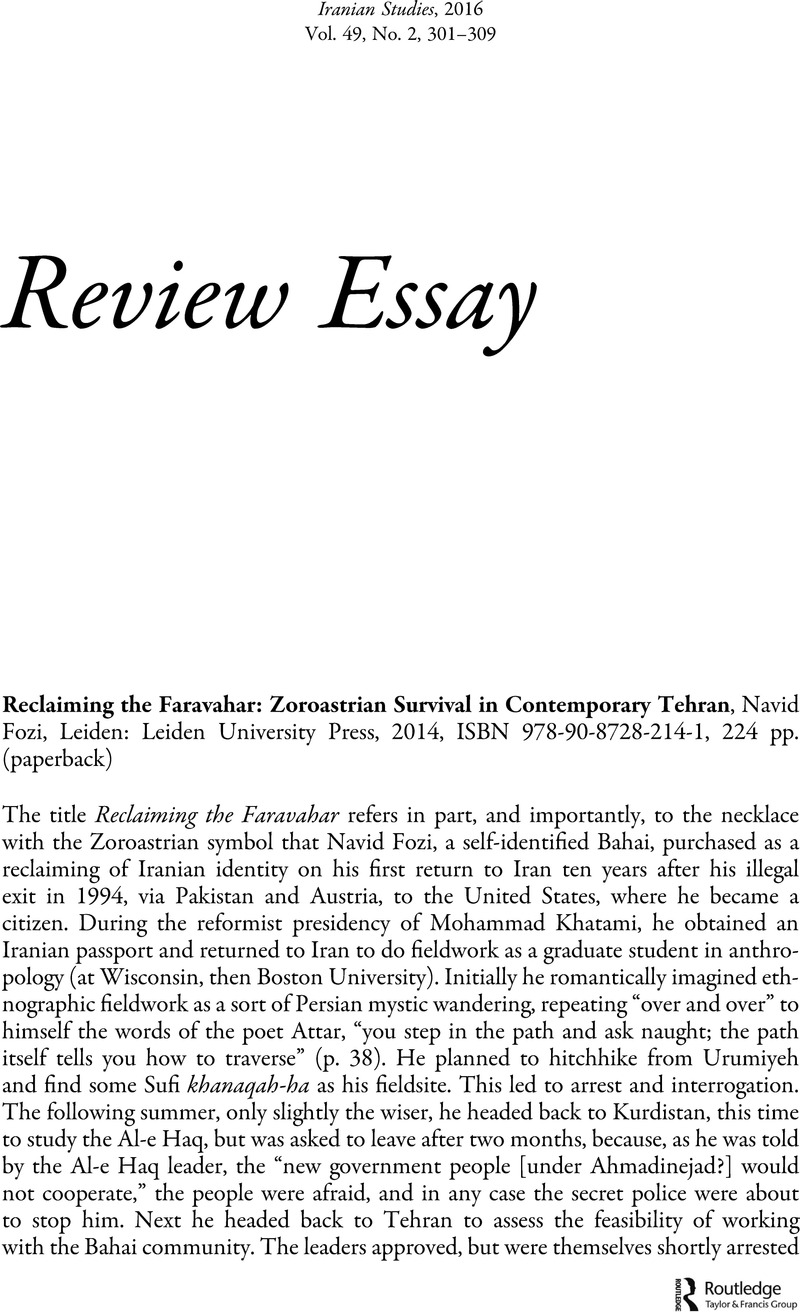No CrossRef data available.
Article contents
Review Essay
Review products
Reclaiming the Faravahar: Zoroastrian Survival in Contemporary Tehran, Fozi Navid, Leiden: Leiden University Press, 2014, ISBN 978-90-8728-214-1, 224 pp. (paperback)
Published online by Cambridge University Press: 01 January 2022
Abstract
An abstract is not available for this content so a preview has been provided. Please use the Get access link above for information on how to access this content.

- Type
- Review Essay
- Information
- Copyright
- Copyright © 2016, Michael M.J. Fischer
References
Amighi, Janet. The Zoroastrians: Persistence of a Small Minority Group in Moslem Iran. PhD dissertation, University of Missouri-Columbia, 1984.Google Scholar
Amighi Kestenberg, Janet. The Zoroastrians of Iran: Conversion, Assimilation, or Persistence. New York: AMS Press, 1990.Google Scholar
Corbin, Henri. Les Motifs Zoroastriens dan la Philosophie de Sohrawardi, Shaykh ol Ishraq. Tehran: Editions du Courrier, 1946.Google Scholar
Corbin, Henri. Spiritual Body and Celestial Earth: From Mazdean Iran to Shi'ite Iran. Translated by Pearson, Nancy. London: Tauris, 1960 [1990].Google Scholar
Elman, Yaakov. Authority and Tradition: Toseftan Baraitot in Talmudic Babylonia. Hoboken, NJ: Ktav, 1994.Google Scholar
Fischer, M. M. J. “Zoroastrian Iran: Between Myth and Praxis.” PhD dissertation, University of Chicago, 1973. UMI, Regenstein Library, Cama Oriental Institute, and author's website http://web.mit.edu/anthropology/pdf/cvs/fischer_publications.pdfGoogle Scholar
Fischer, M. M. J. Iran: From Religious Dispute to Revolution. Cambridge, MA: Harvard University Press, 1980.Google Scholar
Fischer, M. M. J. “Imam Khomeini: Four Ways of Understanding.” in Voices of Islamic Resurgence, edited by Esposito, John, 150–174. Oxford: Oxford University Press, 1983.Google Scholar
Fischer, M. M. J. “Sacred Circles: Iranian (Zoroastrian and Shi'ite Muslim) Feasting and Pilgrimage Circuits.” In Sacred Spaces and Profane Places, edited by Scott, J. S. and Simpson-Housley, P. New York: Greenwood Press, 1990, pp. 131–44.Google Scholar
Fischer, M. M. J. Mute Dreams, Blind Owls, and Dispersed Knowledges: Persian Poesis in the Transnational Circuitry. Durham, NC: Duke University Press, 2004.Google Scholar
Fischer, M. M. J. and Mehdi Abedi, M. Debating Muslims: Cultural Dialogues in Postmodernity and Tradition. Madison: University of Wisconsin Press, 1990.Google Scholar
Herman, Geoffrey. A Prince without a Kingdom: The Exilarch in the Sassanian Era. Tuebingen: Mohr Siebeck, 2012.CrossRefGoogle Scholar
Herman, Geoffrey, ed. Jews, Christians and Zoroastrians: Religious Dynamics in a Sasanian Context (Judaism in Context). Piscataway, NJ: Gorgias, 2014.Google Scholar
Hertz, Robert. “Contribution à un étude sur la représentation collective de la mort.” Année Sociologique, 1907. 10: 48–137.Google Scholar
Hertz, Robert. Death and the Right Hand. Translated by Rodney and Claudia Needham. London: Cohen and West, 1960.Google Scholar
Langer, Robert. “From Private Shrine to Pilgrimage Center: the Spectrum of Zoroastrian Shrines in Iran.” In Stausberg, Michael ed. Zoroastrian Rituals in Context. Leiden: Brill, 2004, pp. 563–594.Google Scholar
Neusner, Jacob. Persia and Rome in Classical Judaism. Lanham, MD: University Press of America, 2008.Google Scholar
Secunda, Shai, and Fine, Steven, eds. Shoshanat Yaakov: Jewish and Iranian Studies in Honor of Yaakov Elman. Leiden: Brill, 2012.CrossRefGoogle Scholar
Secunda, Shai. The Iranian Talmud: Reading the Bavli in Its Sassanian Contexts. Philadelphia: University of Pennsylvania Press, 2013.Google Scholar
Shaked, Shaul. Dualism in Transformation (Jordan Lectures in Comparative Religion). London: University of London, SOAS, 1994.Google Scholar
Tabatabai, S. Muhammad-Husayn, et al. Bahth-i dabara marja'iyyat va ruhaniyyat. Tehran: Intishar, 1341 (1962 C.E.).Google Scholar
Windfuhr, Gernot. “Vohu Manu: A Key to the Zoroastrian Word Formula.” In Michigan Studies in Honor of George G. Cameron, edited by Orlin, Louis L., 269–310. Ann Arbor, MI: Department of Near Eastern Studies, 1976.Google Scholar
Zia'i, Hossein. Knowledge and Illumination: A Study of Suhrawardi's Hikmat al-Ishraw. Brown Judaic Studies, no. 97. Atlanta, GA: Scholars Press, 1990.Google Scholar
Zia'i, Hossein. “The Source and Nature of Authority: A Study of al-Suhrawardi's Illuminationist Political Doctrine.” In The Political Aspects of Islamic Philosophy: Essays in Honor of Muhsin Mahdi, edited by Butterworth, Charles. Cambridge, MA: Harvard University Press, 1992.Google Scholar


